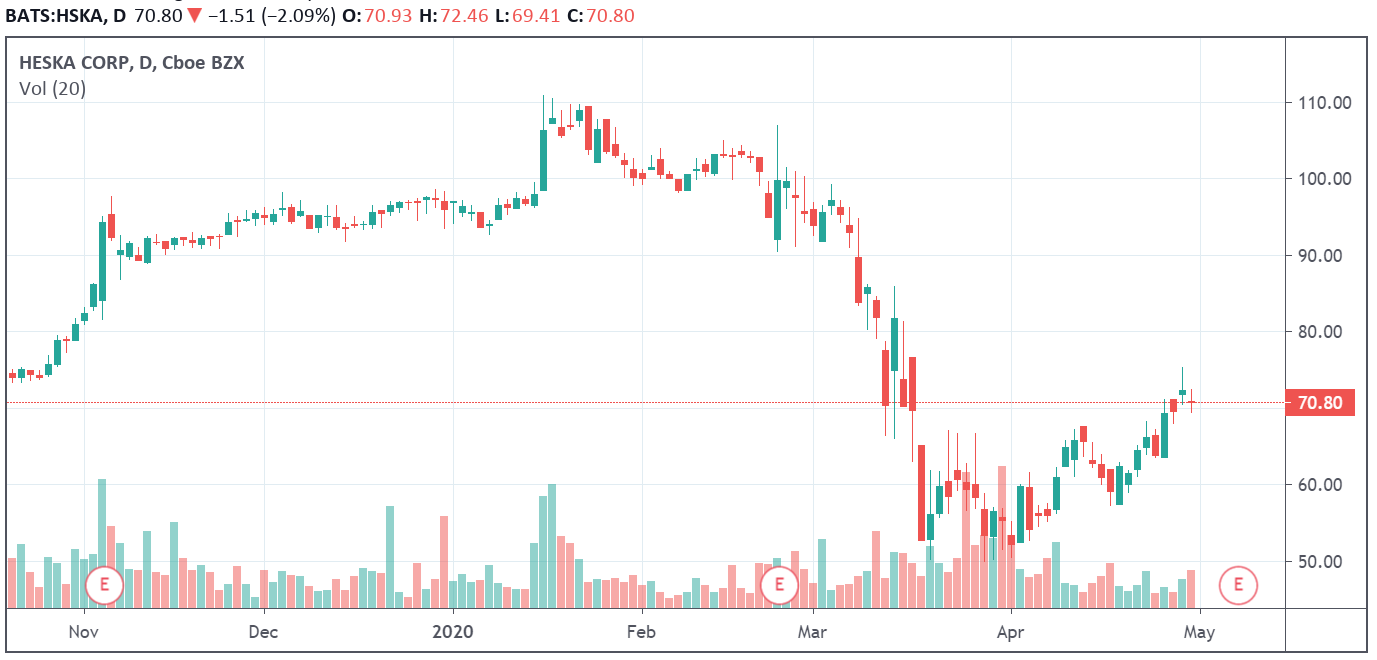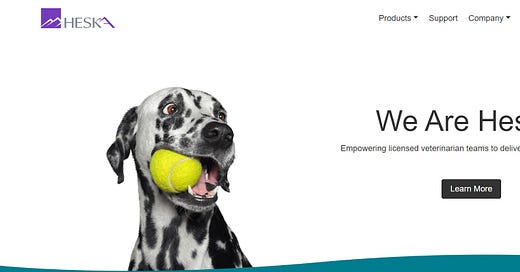Heska Corp (HSKA): Growing Animal Diagnostics Company For Cheap

HSKA sells veterinary and animal health diagnostic and specialty products. Their offerings include Point of Care diagnostic laboratory instruments and supplies; digital imaging diagnostic products, software and services; vaccines; local and cloud-based data services; allergy testing and immunotherapy; and single-use offerings such as in-clinic diagnostic tests and heartworm preventative products.
Products & Services
HSKA is composed of two segments:
Core companion Animal (CCA)
The CCA segment is mostly for canine and feline use, POC lab instruments and consumables. They also provide digital imaging diagnostic instruments, software and services and cloud-based data storage.
This segment accounts for 87% of HSKA's revenues.
Other Vaccines and Pharmaceuticals (OVP)
OVP includes private label vaccine and pharmaceutical production (mainly for cattle). OVP products are sold by third parties under third party labels. This segment represents the remaining 13% of revenues.
Financials: Razor-Razor Blade Model
CCA Drives Core Business
The company uses a razor blade model with their lab equipment. They sell the instrument and place it under contract to provide future testing consumables (think cartridges and reagents). As vets use the instruments, they have to order more cartridges and reagents. Think of it like your Keurig coffee maker.
The real money (and high margin) is in the cartridges -- the consumable products. This is shown in HSKA's financials. Last year they did $53.6M in revenue from consumables and only $12.1M in outright instrument sales.
The goal of this strategy is to get as many vets to own the instrument. Then, once you reach scale, lock in multi-year contracts to supply the "razor blade" consumable accessories.
This is an important concept when thinking about the future of HSKA's business. Top-line revenues will not show the potential growth in the company for two reasons. First, lab instruments are lower margin products and harder to get into every vet shop. It takes time. Second, the real revenue and profits come after multiple uses of the instrument -- which don't happen overnight.
In other words, HSKA gets a customer via a low-margin instrument, then makes a killing on supplying that vet with the consumables needed to support that instrument.
Additionally, HSKA sells Point of Care digital imaging software. This makes up around $26M in 2019 revenue. Unlike their lab instruments, most of their POC revenue arrives upfront. They also have service and support contracts with the customer.
The CCA business did $106M in revenue and $53M in total gross profit in 2019. This core segment produces 50% gross margins. That number indicates market leadership.
OVP: Call Option on Vaccine Manufacturing
HSKA's OVP segment is relatively insignificant in terms of revenues. But the company's excited about its prospects. This segment includes a 16,000 sqft USDA and FDA licensed production facility in Des Moines, IA.
In their 2019 10-K, the company said they view this facility as a long-term asset due to "vaccines that we may commercialize in the future." This is an interesting thought, as HSKA's OVP division could turn into a vaccine drug contract manufacturer. And we know those are great businesses (i.e., CDMO).
This business remains a low margin, low revenue segment. In 2019, OVP did $16M in revenues and $802K in gross profit.
Revenue Decline & Increased Investments Lead To Losses
HSKA's revenues have declined each of the last three years, from $129M in 2017 to $122M in 2019. This is a cause for concern going forward. A bulk of the HSKA thesis relies on the company growing its core business at above-market rates.
But again, we shouldn't read too much into the revenue figures as most of the company's revenues come after they sell the lab equipment.

Gross Profit remains (roughly) the same, which shows the power of their razor-blade model not impacting bottom-line sales. Gross margins came in at 44.6% last year. That's impressive. So the operating business remains solid despite reduced revenue growth.
If you look at the quarterly figures for 2019, you see a different picture. HSKA lost $75K in Q1 and $566K in Q2. Again, this was due to increased investment, acquisitions and growth expenses (salaries, etc.). By Q4 they did $775K in operating income.
HSKA's three-year revenue decline helps explain Mr. Market's sell-off.
In essence, our bet is that the future will look a lot different than the present (and recent past). The HSKA of tomorrow will generate more revenue, garner higher market share, and increase competitive advantage as they install their equipment in numerous vets around the world.
The company has funded its growth and investment through cash from operations. Going forward, there should be no reason to both dilute shareholders nor issue debt to maintain their core business.
The Balance Sheet: Net Cash & Strong
HSKA has a strong balance sheet despite its aggressive R&D investment and growth initiatives. The company has $42.5M in net cash, and enough cash to pay total liabilities. We like that strength going into a rough couple of quarters (Q1 & Q2 of 2020).
This further strengthens our base case of HSKA not needing outside capital or funding to support its operating activities.
Other Things I Like To See: Insider Ownership
HSKA's management owns close to 12% of the outstanding shares. Their CEO, Kevin Wilson, owns almost 8% himself. We're also seeing increased buying from directors during the first week of April.
Heska's Future: Global Leader with Higher Revenues & Profits
HSKA trades less than 4x sales. What is Mr. Market implying with this valuation? In short, Mr. Market's expecting zero revenue growth beyond 2020. At 4x sales, you're betting HSKA never grows past $140M (or so) in top-line revenue.
We think the above scenario is a low probability event.
What's a more likely outcome? The last few years' revenue growth might not be a good proxy for the next five. If we look at 2015-2016 we see 16% and 24% growth, respectively. Management expects at least a 14% increase this year. And if you include the new acquisitions, we see a clear path towards $200M in revenues within the next five years.
Let's assume we get $140M in revenue this year. Then, over the next four years, the company maintains double-digit revenue growth -- 14-10%. Under these assumptions, we get $200M in revenue by 2023, and a chance at $221M by 2024.
What if we assume zero multiple expansion over the next five years? If HSKA stays around 4x sales, we end 2023 with an EV of $800M. That's almost double the current enterprise value. But, a company growing double-digit revenues, taking market share and maintaining a strong balance sheet should trade higher than that. What that number is, I'm not sure.
Risks: Competition, Industry Slow-Down and Revenue Model
There's a few main risks with HSKA's bullish thesis:
Stiff competition from larger competitors (IDEXX, ALGN, etc.)
An industry slowdown, causing vet practices to delay purchasing of lab equipment
HSKA's revenue model depends on vet labs purchasing more consumables products over time. If HSKA isn't able to generate higher margins on these consumable products, it will have a strong negative impact on their revenues and profits.
Third-party manufacturers: HSKA heavily relies on third-party manufacturers for their lab equipment and consumables. Ideally, you'd like the company to have more control over their supply and manufacturing. And if we've seen anything from COVID-19 -- it's that dependence on third-party manufacturing doesn't always work. That said, they have a 16,000 sqft facility that could eventually be turned into such a place.
Brandon Beylo is a value investing specialist for over 13 years spending his time in small to micro-cap companies, spin-offs, SPACs and deep value liquidation situations.


